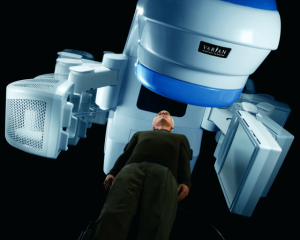by
Kathy Mahdoubi, Senior Correspondent | November 13, 2009

The Trilogy™ medical linear
accelerator from Varian
Medical Systems.
This report originally appeared in the October 2009 issue of DOTmed Business News
According to the American Cancer Society, almost 1.5 million new cases of cancer are expected to be diagnosed in the U.S. this year, and over half a million Americans are expected to die of cancer. That's more than 1,500 people per day, which makes it one of the leading causes of death in the country - second only to heart disease. The silver lining - or beam in this case - is that a growing number of treatments are available to combat the disease. Linear particle accelerators and simulators have shaped-up to be among the most powerful systems for delivering precise radiation therapy and radiosurgery.
Like many medical equipment markets today, the linear accelerator segment of the industry is stretched-thin due to economic pressures and recent changes to Centers for Medicare and Medicaid Services (CMS) reimbursement practices. Some experts believe another 50% cut in reimbursement may be yet to come. Still, new techniques are delivering increasingly targeted and more aggressive radiation therapies in fewer sessions, resulting in some remarkable improvements in cancer outcomes.



Ad Statistics
Times Displayed: 6
Times Visited: 2 Fast-moving cardiac structures have a big impact on imaging. Fujifilm’s SCENARIA View premium performance CT brings solutions to address motion in Coronary CTA while delivering unique dose saving and workflow increasing benefits.
A 3D representation showing
a 360 degree single arc
SmartArc plan for a
head and neck treatment.
(Image courtesy of Philips)
Linear accelerators, or linacs, are essentially external beam radiation therapy systems that use microwave technology to produce electron and/or photon beams powerful enough to damage or destroy tissues. The majority of radiotherapy procedures carried out by linear accelerators are for the curative, therapeutic or palliative treatment of cancer and this technology has the ability to home in on a wide variety of malignancies throughout the body, whether on the skin, breast, prostate, deep inside the brain, or now, with respiratory gating, the hard-to-pin-down lungs and liver.
It's all in the application
In the current market, a new linear accelerator can cost anywhere from $1.5 to $3 million. Linacs are used primarily in a limited but critical handful of applications. Intensity modulated radiation therapy (IMRT) is the new gold standard of radiation therapy and involves using beams of varying energies that can deliver very specific radiation doses to targeted lesions in the actual shape of the tumor - this is thanks to the modern multi-leaf collimator (MLC). The MLC uses radiation-blocking "leaves" that can be programmed to make the beam conform to the shape of the tumor. The high-end systems are precise to within a couple of millimeters.

